Spinach is a fast-growing, cool-weather loving, versatile kitchen vegetable that also happens to be one of the easiest of all garden plants to grow!
Even better, it can be grown in either the spring or fall as long as the temperatures stay cool and pleasant. It makes for a perfect early spring crop because as soon as it’s done growing, you can simply pull it up and plant your warm-weather plants in its place.
There are many different ways to enjoy using spinach in your kitchen. You can use smaller, more tender leaves fresh in salads and smoothies. With the larger leaves, you can wilt them for use in soups, stews and many pasta dishes.
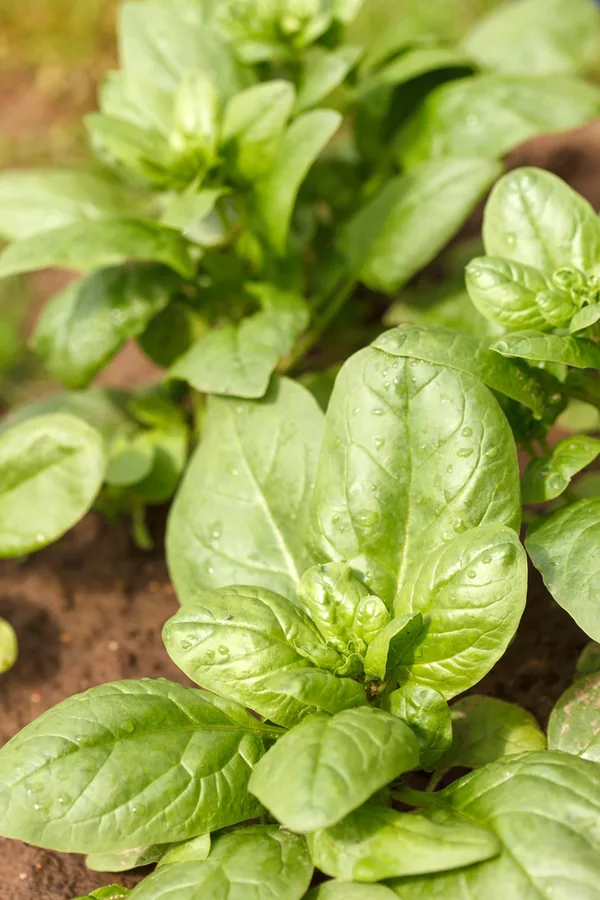
In fact, the possibilities are almost endless when it comes to consuming spinach! And not only is spinach delicious in many culinary dishes, but it is highly nutritious as well. Spinach is high in iron; manganese; and Vitamins A, B, and K (think Popeye!).
And is spinach ever easy to grow. Spinach seeds can be directly sown, started indoors, or you can use transplants. It grows perfectly in pots and containers as well as directly in the garden soil. With all of its benefits, it’s no wonder why so many people want to grow this amazing vegetable!
Varieties of Spinach – How To Grow Spinach
There are three main types of spinach available, all with multiple cultivators of each type.
The first is Savoy Spinach, also known as curly-leaf spinach. This type features deeply crinkled leaves that are dark green in appearance. It can be difficult to clean due to its severe wrinkles. Savoy spinach is able to handle severely cold temperatures better than any other type.
The second type is Semi-Savoy Spinach. This type features leaves that are less severely crinkled which makes them easier to clean. In addition, semi-savoy spinach is less likely to develop disease and isn’t as quick to bolt. This makes semi-savoy spinach an excellent choice for home gardeners.
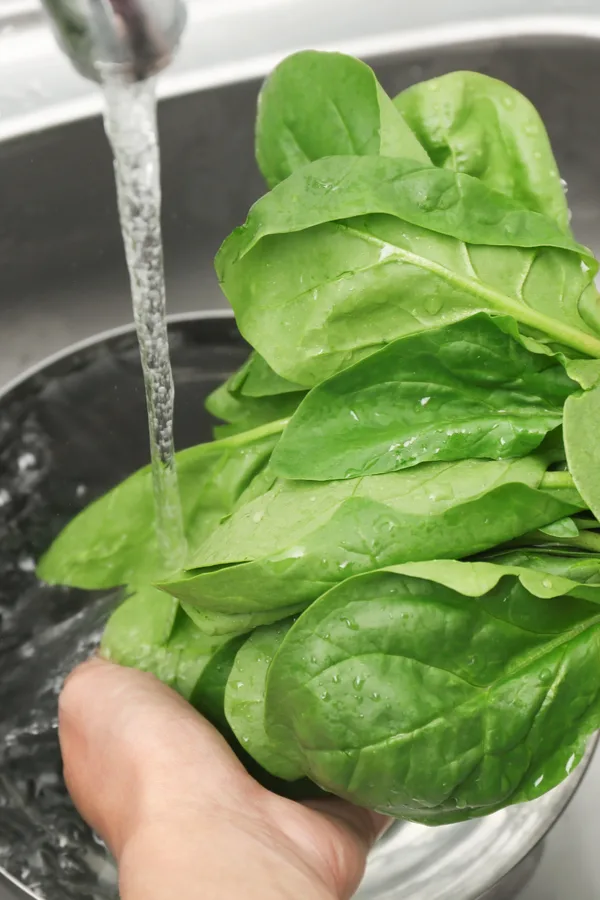
The last type is Smooth Leafed Spinach. As its name entails, it features smooth leaves that are broad and flat in nature. This is the variety that is often used as processed spinach.
No matter the type of spinach you choose, they tend to all be around 6 to 12 inches tall as well as wide. Spinach can be grown outdoors in Growing Zones 2-11, but anyone can grow them indoors with the right conditions.
Spinach grows best in temperatures ranging from 35 to 70º Fahrenheit (2 to 21º Celsius). It can even survive temps down to 20º F (7ºC) in Growing Zones 8 or below as long as plants are previously established.
How To Plant, Grow, And Maintain Spinach
Soil Requirements for Growing Spinach
Spinach thrives in well-draining, organically rich, and loamy soil. Aim for a neutral soil pH of around 6.5 to 7.5. Amend your soil with compost to help boost the nutrient value of your soil and to give the spinach a head start.
You also want soil that will be able to retain adequate moisture. While you want the soil to be able to hold a bit of moisture, you also don’t want there to be any standing water.
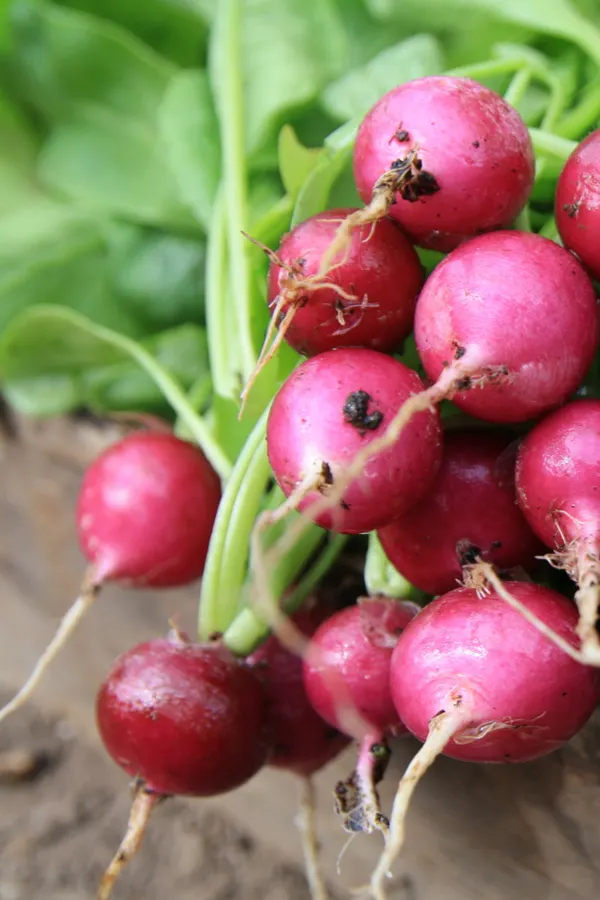
Planting Spinach
It only takes spinach about 6 weeks to go from seed to harvest. With that in mind, you can plant seeds every 2 to 3 weeks to to extend your growing season with multiple harvest times.
Aim for getting your first batch of seeds in the ground about 4 to 6 weeks before your last spring frost date for a spring harvest, or as soon as the ground can be worked. For a fall harvest, plant seeds about 6 to 8 weeks before your first expected frost.
In the late spring or early summer when the daylight gets longer than 14 hours, spinach has a tendency to bolt. This will turn it bitter and nearly inedible. For this reason, it is best to avoid planting during the hottest parts of summer.
With its ability to handle cooler temps, spinach is a great cold frame winter crop. You can also use a cold frame to protect plants from frost and extend your growing season in late fall.
Starting Seeds Indoors
When starting your spinach seeds indoors, ensure that you are using a soil mixture that is made specifically for starting seeds. These mixtures are light and airy, which helps to promote germination. You can use purchased pre-made mixtures or make the mixture yourself.
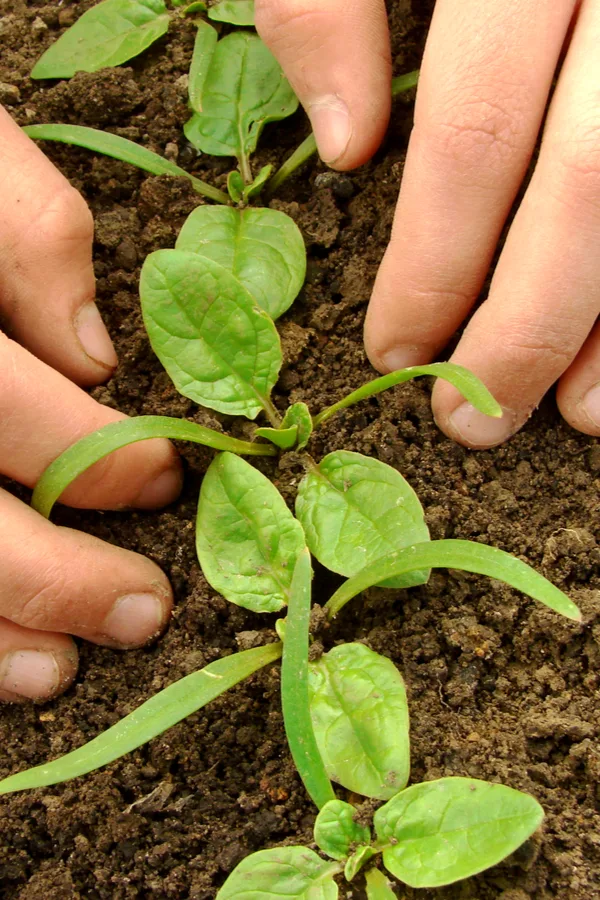
Depending on the size of your growing cells, place a couple of seeds per container about ½ inch below the surface line. Cover with soil and water well. Keep the soil moist but not saturated.
At this point, you do not need to turn your grow lights on yet. Seeds will start to germinate in about 5 days. Once seeds pop through the soil, you can use your grow lights to help promote growth. Keep lights only a few inches above the plants and for about 12 hours per day.
When plants are a few inches tall, thin so that you only have one plant per growing cell. Transplant into your garden after the threat of frost has passed in the early spring.
Planting Seeds Outdoors
For many, it is easiest to direct sow spinach right into the garden. Spinach can be grown in full sun or partial shade. Consider using a spot that is in full sun for fall planting and a location that has partial shade for spring planting. These will balance out the hot and cold to produce the best spinach possible.
Loosen up about 4-6 inches of soil prior to planting. Amend with compost if your soil is lacking in nutrients and organic matter.
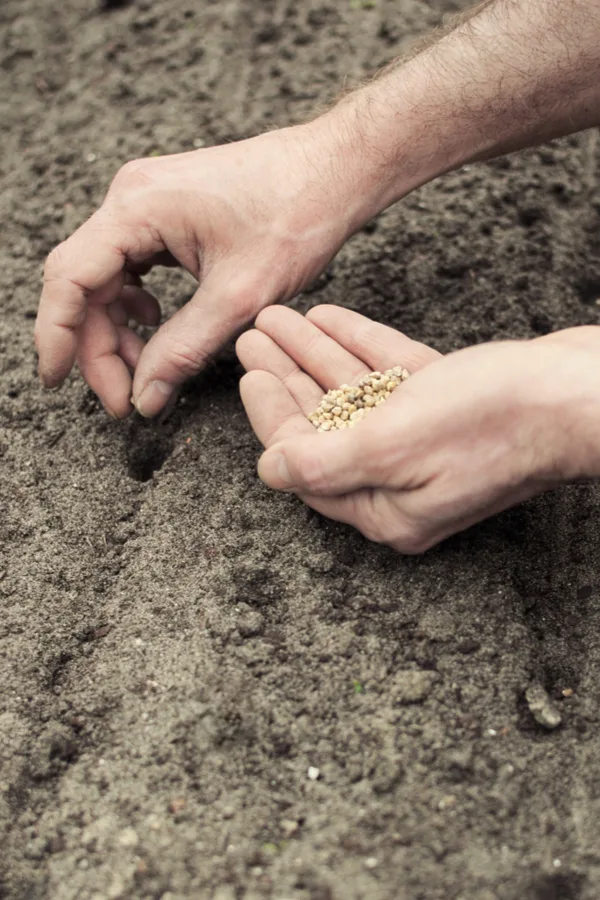
Dig a small trench or holes that are about ¼ to ½ inch deep. Space rows about a foot apart to give plants ample space to grow. Drop your seeds into the hole or trench, and cover lightly with soil. Water well.
Once seedlings have germinated and are a few inches tall, thin plants so you end up with one spinach plant every 4 to 6 inches. You will need to protect young plants from unexpected frosts. One of the easiest ways is to cover them with a light blanket or sheet.
After sowing seeds, make sure to cover the soil with an organic mulch. Straw, shredded leaves, or even grass clippings all make for excellent mulch.
Planting In Containers
You can also grow spinach easily in pots or containers. Choose a container that is around 8-12 inches deep and about the same width. The container needs to have drainage holes so excess water can drain out.
With spinach, you can certainly think outside the box and be creative with the type of container you use. To pot up, mix a few inches of compost into your potting soil prior to planting. You can either start your spinach from seeds or plant transplants instead when using containers.
Long-Term Care – How To Grow and Maintain Spinach
Watering
Spinach plants like to have the soil moist, but they don’t like standing water. Aim for around 1 inch or more of water each week, either by rainfall or hand watering. Since the plants like to be in moist soil, try to water a few times each week as opposed to one heavy saturation.
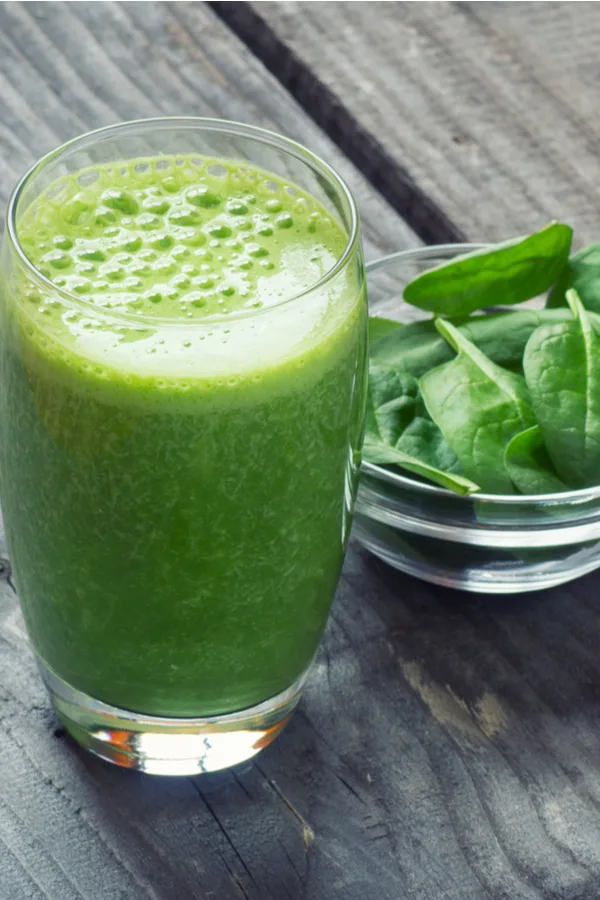
Placing a few inches of mulch around spinach plants helps to retain moisture. As an added benefit, the mulch will also help discourage weeds from growing and stealing nutrients from the crop.
Fertilizing
Because spinach is such a fast grower, it can benefit from a few applications of fertilizer throughout the growing season. Wait until you see at least 4 leaves on the plants before applying any fertilizer.
Use a slow-release, all-purpose liquid fertilizer that has higher nitrogen levels every few weeks. Compost tea is a great 100% natural, 100% organic fertilizer to use. It can absorb rapidly into the soil and through the leaves of the spinach.
Pests & Issues
There are a few pests that can be a problem when growing spinach. Flea beetles, spider mites, and aphids can all cause damage to your crop. In addition, cutworms, leafminers and slugs can also infect spinach plants. If needed, neem oil can be used to organically treat the spinach against pests.
As far as diseases that affect the crop, downy mildew is the most common of all. This is caused by overly wet and humid conditions. Powdery mildew, white rust, and spinach blight can also be problematic with spinach.
Harvesting
As mentioned earlier, spinach can be harvested around 6 weeks after planting from seeds. You can harvest the leaves early for tender baby spinach flavor, but around 6 inches is a great size for great taste and a sizable harvest.
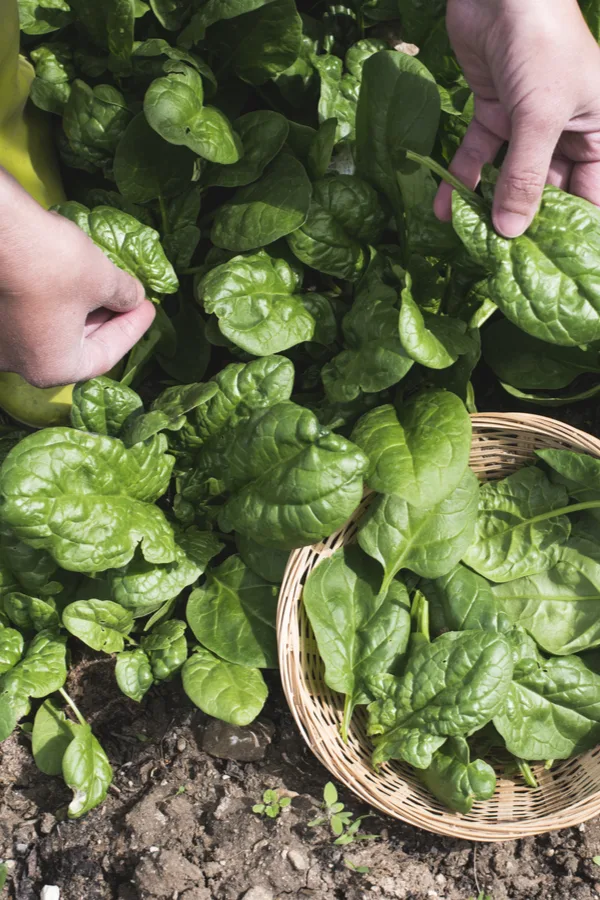
Typically, you can harvest spinach and it will keep on producing new leaves. Start by harvesting the outer layers first and letting the smaller inner layers continue to grow. Use a pair of sharp kitchen scissors and simply snip off the leaves about an inch above the base of the plant.
How To Store Spinach Leaves
The best way to store harvested spinach is by wrapping the leaves in a dry paper towel. Excess moisture can speed up the decaying process, so keeping it dry is key.
Place the spinach bundle into a sealed zip-lock back or a container with a tight lid. The spinach should last up to 10 days if kept in your refrigerator’s crisper drawer.
Avoid keeping spinach next to ethylene-producing fruits like apples and bananas. You can tell when spinach starts to go bad. It will start to lose its bright green color and turn wilted and slimy.
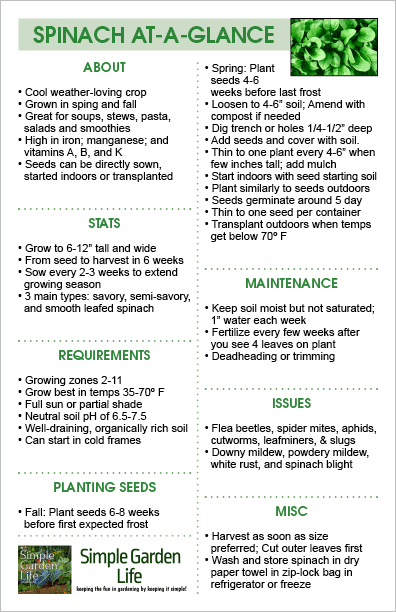
You can also freeze spinach for later use in your off-season recipes. For an in-depth look at how to do this, check out the article, “How To Easily Freeze Spinach.” The good news is that frozen spinach can last up to 12 months when stored properly.
To Conclude…
If you are looking for a versatile vegetable plant that grows quickly, doesn’t take up a lot of space, and is delicious to eat, then spinach is the plant for you! Enjoy growing this cold-weather-loving plant this spring and fall!.
Feel free to download, print out, or save our Spinach At-A-Glance sheet above. It is sized for half letter printing but can be scaled if needed.
Follow Our Facebook Page For Even More Great Tips! Simple Garden Life Facebook Page
Simple Garden Life is a website dedicated to keeping gardening fun, simple and enjoyable! We publish two new articles each week along with a new garden podcast episode every two weeks. This article may contain affiliate links.
